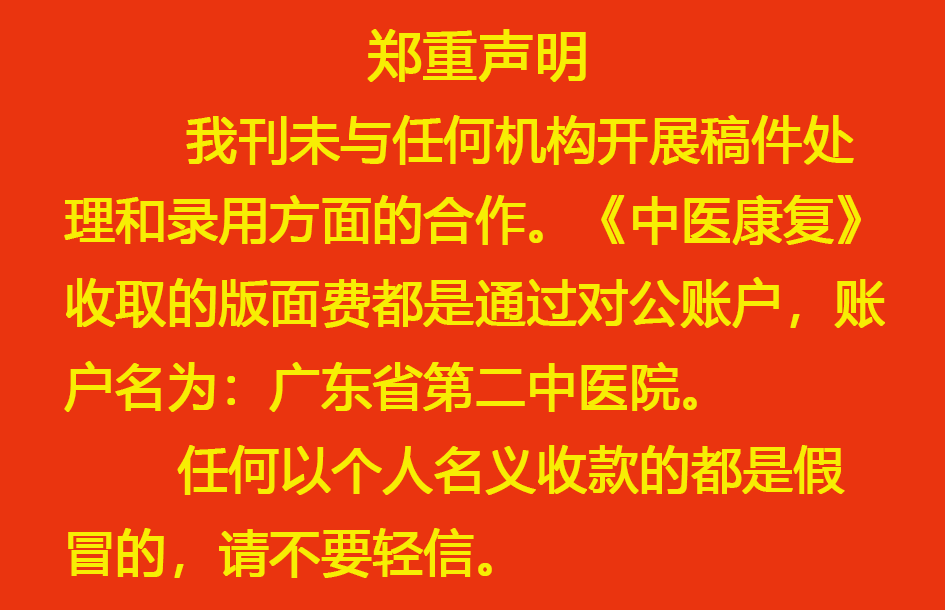| 摘要: |
| 目的:探讨太极云手结合机器人辅助训练对脑卒中患者手功能的康复效果。方法:将 60例脑卒中患者随机分为治 疗组(n=30)和对照组(n=30),两组均接受常规康复治疗,治疗组接受太极云手训练结合结合机器人辅助训练,对照组接受机 器人辅助训练。两组的训练频率为 60min/天,5天/周,持续治疗 8周。于治疗前、治疗4周后、治疗 8周后采用Fugl-Meyer运动 功能量表 (Fugl-Meyer motor assessment, FMA)腕手部分、Wolf 运动功能量表(Wolf motor function test, WMFT)、箱块测试 (Box and Block test, BBT)、握力和捏力来评估受试者的手功能。结果:两组患者治疗后与治疗前比较,差异具有统计学意义 (P<0.001)。 治疗 4 周后组间比较差异不具有统计学意义(P>0.05);治疗8 周后组间比较,WMFT 差异具有统计学意义(P< 0.05),FMA腕手部分、BBT、握力和捏力不具有统计学差异(P>0.05)。 结论:太极云手结合机器人辅助训练能够改善脑卒中患 者的手功能。 |
| 关键词: 脑卒中 太极云手 机器人辅助训练 手功能 康复 |
| DOI:10. 19787/j.issn.2097-3128.2024.01.004 |
| 投稿时间:2023-02-01修订日期:2023-02-15 |
| 基金项目:浦东新区“国家中医药发展综合改革试验区”建设项目(NO.PDZY-2022-0702);上海市卫健委中医药科研项目(NO. 2020LP004) |
|
| Effects of Body Weight Support-Tai Chi Yunshou Training on Upper Limb Motor Function in Stroke Patients |
| ZHANG Li-ying1, WANG Jie-ning1,2, YU Xiao-ming2, LU Yan2 |
| (1.No. 7 Clinical College of Medicine,Shanghai University of Traditional Chinese Medicine, Shanghai, 201203; 2.Department of Rehabilitation Medicine, Seventh People's Hospital Affiliated to Shanghai University of Traditional Chinese Medicine, Shanghai, 200137) |
| Abstract: |
| Objective: To explore the rehabilitation effect of Tai Chi Yunshou combined with robot-assisted training on hand function of stroke patients. Method: A total of 60 stroke patients were selected and randomly divided into a treatment group (n=30) and a control group (n=30). Both groups received conventional rehabilitation therapy. The treatment group received Tai Chi Yunshou training combined with robot-assisted training, the control group received robot-assisted training. The training frequency of the two groups was 60min/day, 5 days/week, and the treatment continued for 8 weeks. Before treatment, after 4 weeks of treatment, and after 8 weeks of treatment, the Fugl-Meyer motor function scale (FMA) wrist-hand part, the Wolf motor function test (WMFT), Box and Block Test (BBT), grip strength and pinch strength to assess the hand function. Result: The dif‐ ference between the two groups of patients after treatment and before treatment was statistically significant (P<0.001). There was no statistically sig‐ nificant difference between the groups after 4 weeks of treatment (P>0.05). After 8 weeks of treatment, the difference in WMFT between the groups was statistically significant (P>0.05). FMA wrist-hand part, BBT, grip strength and pinch strength were not statistically different (P>0.05). Conclu‐ sion: Tai Chi Yunshou combined with robot-assisted training can improve hand function in stroke patients. |
| Key words: stroke Tai Chi Yunshou robot assistant training hand function rehabilitation |
